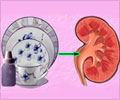According to a new study, while more men than women develop kidney stones women are more than twice as likely to suffer infections related to the condition.

The findings were published today in the peer-reviewed European Urology, the official publication of the European Association of Urology.
Not only did the study find that women are far more susceptible to infection when they develop urolithiasis, it also showed that the incidence of infection, including sepsis – a potentially fatal inflammation throughout the body touched off by infection –is on the rise.
The rate of related deaths, however, held steady, whom the researchers said is likely a result of "broad improvement in the management of sepsis and the critically ill."
"The research study was conducted because the rate of infection related to urolithiasis was not known, and evidence was unclear about the best method for treating it," said the study's lead author, Jesse Sammon, DO, Urology Resident at Henry Ford's Vattikuti Urology Institute.
Nearly 400,000 adult patients hospitalized with infected urolithiasis from 1999-2009 were identified in the Nationwide Inpatient Sample, the largest all-payer inpatient care database in the U.S. Researchers then determined how often they were treated with either of two techniques – retrograde ureteral catheterization, or RUC, and percutaneous nephrostomy, or PCN.
Advertisement
During the 10-year period studied by the researchers, the incidence of infected urolithiasis in women increased from 15.5 per 100,000, to 27.6. In men, there was an increase of 7.8 per 100,000, to 12.1. Related sepsis rose from 6.9 percent of urolithiasis patients to 8.5 percent, and severe sepsis increased from 1.7 percent to 3.2 percent.
Advertisement
So conclusions that might be used to guide current and future treatment options would be hypothetical, they said, "demonstrating the pressing need for further study."
Source-Eurekalert














